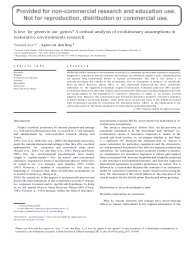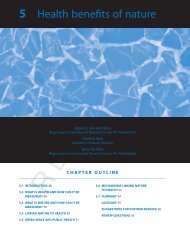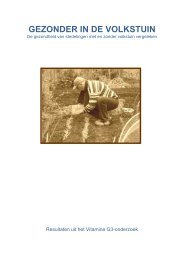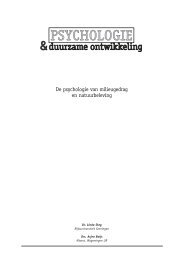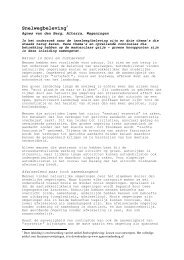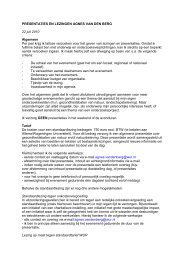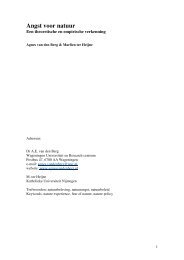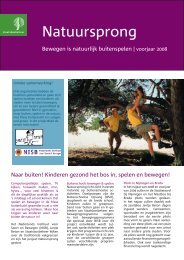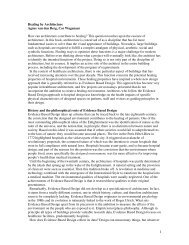New wilderness in the Netherlands - Agnes van den Berg
New wilderness in the Netherlands - Agnes van den Berg
New wilderness in the Netherlands - Agnes van den Berg
You also want an ePaper? Increase the reach of your titles
YUMPU automatically turns print PDFs into web optimized ePapers that Google loves.
370 A.E. Van <strong>den</strong> <strong>Berg</strong>, S.L. Koole / Landscape and Urban Plann<strong>in</strong>g 78 (2006) 362–372preferences for nature development landscapes (Van <strong>den</strong> <strong>Berg</strong>,2003; Van <strong>den</strong> <strong>Berg</strong> and Vlek, 1998; Van <strong>den</strong> <strong>Berg</strong> et al., 1998,<strong>in</strong> press).Averaged across <strong>the</strong> six areas, plans to develop wild naturalsett<strong>in</strong>gs were rated as more beautiful than plans to developmanaged sett<strong>in</strong>gs. This f<strong>in</strong>d<strong>in</strong>g fits well with f<strong>in</strong>d<strong>in</strong>gs of studies<strong>in</strong> o<strong>the</strong>r countries, which have also found a general “taste for<strong>wilderness</strong>” (e.g., Arriaza et al., 2004). However, it is importantto note that <strong>the</strong> present research did not employ representativesamples of respon<strong>den</strong>ts and landscapes. The present f<strong>in</strong>d<strong>in</strong>gthat <strong>wilderness</strong> landscapes were generally preferred over managednatural landscapes should <strong>the</strong>refore be <strong>in</strong>terpreted withcaution.Although wild nature development landscapes were generallypreferred over managed landscapes, <strong>wilderness</strong> was notappreciated <strong>in</strong> all areas. In <strong>the</strong> fourth area, a plan to developa wild forest was evaluated less beautiful than a plan to developa more managed forest. Both resi<strong>den</strong>ts and nonresi<strong>den</strong>ts displayeda preference for <strong>the</strong> managed forest, which suggests thatthis f<strong>in</strong>d<strong>in</strong>g cannot be attributed to contextual <strong>in</strong>fluences, such asa resistance to change by local resi<strong>den</strong>ts. Conceivably, <strong>the</strong> wildnatural landscape <strong>in</strong> <strong>the</strong> fourth area may have received low preferencerat<strong>in</strong>gs because of <strong>the</strong> <strong>den</strong>se foreground and mid-groundunderbrush, characteristics which have been found to <strong>in</strong>fluencevisual preferences for forests <strong>in</strong> a negative way, irrespective of<strong>the</strong> degree of <strong>wilderness</strong> (Schroeder and Daniel, 1981; Brownand Daniel, 1986). Alternatively, it is also possible that <strong>wilderness</strong>is less appreciated <strong>in</strong> forests than <strong>in</strong> o<strong>the</strong>r types of naturallandscapes because structure and order are more important <strong>in</strong><strong>the</strong>se highly <strong>den</strong>se and complex environments.Consistent with our expectations, local resi<strong>den</strong>ts displayedhigher preferences for <strong>the</strong> development of managed nature <strong>in</strong><strong>the</strong>ir area than nonresi<strong>den</strong>ts. Resi<strong>den</strong>ts did not, however, displaylower preferences for <strong>the</strong> development of wild nature <strong>in</strong><strong>the</strong>ir area than nonresi<strong>den</strong>ts. The higher preference for managednature was strongest among resi<strong>den</strong>ts of <strong>the</strong> second plan area(Area “De Burd” <strong>in</strong> Friesland). Because <strong>the</strong>re had been somelocal resistance to nature development <strong>in</strong> this area, higher preferencesfor managed nature by resi<strong>den</strong>ts of this area may havereflected a momentary <strong>in</strong>fluence of <strong>the</strong> planned-change context(cf. Van <strong>den</strong> <strong>Berg</strong> and Vlek, 1998). However, resi<strong>den</strong>ts of <strong>the</strong> secondarea also displayed higher preferences for managed nature <strong>in</strong>o<strong>the</strong>r regions, which po<strong>in</strong>ts to a more generic effect of familiarityor experience with rural landscapes. Still, because geographicalregion of resi<strong>den</strong>ce was confounded with characteristics of localplann<strong>in</strong>g procedures, <strong>in</strong>terpretations of differences between resi<strong>den</strong>tsand nonresi<strong>den</strong>ts must rema<strong>in</strong> tentative.Among <strong>the</strong> o<strong>the</strong>r socio-economic variables <strong>in</strong>cluded <strong>in</strong> <strong>the</strong>study, age, socio-economic status, farm<strong>in</strong>g background, an<strong>den</strong>vironmentalism were all found to be significantly relatedto <strong>in</strong>dividual differences <strong>in</strong> preferences for <strong>wilderness</strong>. Asexpected, farmers, older respon<strong>den</strong>ts, and respon<strong>den</strong>ts with lowlevels of <strong>in</strong>come and education displayed relatively low preferencesfor wild natural landscapes, while respon<strong>den</strong>ts witha preference for green political parties, younger respon<strong>den</strong>ts,and respon<strong>den</strong>ts with high levels of <strong>in</strong>come and education, displayedrelatively high preferences for wild nature. As <strong>in</strong> previousresearch (e.g. Van <strong>den</strong> <strong>Berg</strong> et al., <strong>in</strong> press) even groups with <strong>the</strong>lowest preferences for <strong>wilderness</strong>, such as farmers, did not ratemanaged nature as significantly more beautiful than wild nature.Ra<strong>the</strong>r, respon<strong>den</strong>ts from <strong>the</strong>se groups rated managed and wildnature as equally beautiful.In l<strong>in</strong>e with our predictions, respon<strong>den</strong>ts who <strong>in</strong>dicated that<strong>the</strong>y visited nature for restoration, reflection, and to study plantsand animals, displayed higher preferences for wild natural landscapesthan respon<strong>den</strong>ts for whom <strong>the</strong>se motives were lessimportant. These f<strong>in</strong>d<strong>in</strong>gs speak to <strong>the</strong> adaptive role of visualpreferences <strong>in</strong> guid<strong>in</strong>g and direct<strong>in</strong>g perceivers to landscapesthat promise to fulfill <strong>the</strong>ir needs (Staats et al., 2003; Koole andVan <strong>den</strong> <strong>Berg</strong>, 2004, 2005; Van <strong>den</strong> <strong>Berg</strong> et al., 2003). Still,recreational motives expla<strong>in</strong>ed only 3% of <strong>the</strong> variance. Consequently,<strong>in</strong>dividual differences <strong>in</strong> <strong>the</strong> appreciation of <strong>wilderness</strong>could not be exhaustively expla<strong>in</strong>ed <strong>in</strong> terms of differences <strong>in</strong>recreational motives.4.1. Limitations and practical implicationsThe present research is subject to several limitations. First,we exam<strong>in</strong>ed people’s evaluations of photographs ra<strong>the</strong>r thanactual natural sett<strong>in</strong>gs. Fortunately, various studies have reportedhigh levels of consistency between visual preferences based onphotographs and parallel responses based on direct experienceof <strong>the</strong> represented landscapes (Daniel, 1990; Kellomaki andSavola<strong>in</strong>en, 1984; Stamps, 1990). Moreover, <strong>the</strong> preference forwild nature that was obta<strong>in</strong>ed <strong>in</strong> <strong>the</strong> present research was corroborated<strong>in</strong> recent Dutch survey among local respon<strong>den</strong>ts whohad had direct experience with nature development landscapes(Buijs et al., 2004). Based on <strong>the</strong>se results, it seems likely that<strong>the</strong> current results will generalize to evaluations of actual naturalsett<strong>in</strong>gs.A fur<strong>the</strong>r limitation is that <strong>the</strong> present research used onlyDutch respon<strong>den</strong>ts. There is reason to believe, however, thatour f<strong>in</strong>d<strong>in</strong>gs are rele<strong>van</strong>t to o<strong>the</strong>r cultures as well. Studies <strong>in</strong>o<strong>the</strong>r countries, <strong>in</strong>clud<strong>in</strong>g nonwestern nations such as Nepal,have yielded similar differences <strong>in</strong> preferences for <strong>wilderness</strong>among groups from different socio-economic backgrounds (seeDurrant and Shumway (2004), for an overview). Never<strong>the</strong>less,it would be <strong>in</strong>formative to extend <strong>the</strong> current analysis to o<strong>the</strong>rcountries, <strong>in</strong> particular countries where <strong>wilderness</strong> is less scarcethan <strong>in</strong> The Ne<strong>the</strong>rlands.F<strong>in</strong>ally, recreational motives were each assessed by only oneitem <strong>in</strong> <strong>the</strong> present research. This relatively crude measurementmay have suppressed <strong>the</strong> predictive power of recreationalmotives. Future work should be directed toward construct<strong>in</strong>g alarger pool of items that covers <strong>the</strong> entire range of recreationalmotives <strong>in</strong> order to obta<strong>in</strong> a better test of <strong>the</strong> rele<strong>van</strong>ce of motivationalaccounts for understand<strong>in</strong>g <strong>in</strong>dividual differences <strong>in</strong> <strong>the</strong>appreciation of <strong>wilderness</strong>.Despite <strong>the</strong> aforementioned limitations, <strong>the</strong> present researchmay have some important practical implications for land agencies.The f<strong>in</strong>d<strong>in</strong>g that <strong>the</strong> majority of respon<strong>den</strong>ts evaluated plansfor nature development <strong>in</strong> <strong>the</strong>ir area as beautiful provides a rationalefor <strong>the</strong> cont<strong>in</strong>uation and implementation of nature developmentstrategies. However, as already noted, this f<strong>in</strong>d<strong>in</strong>g should



